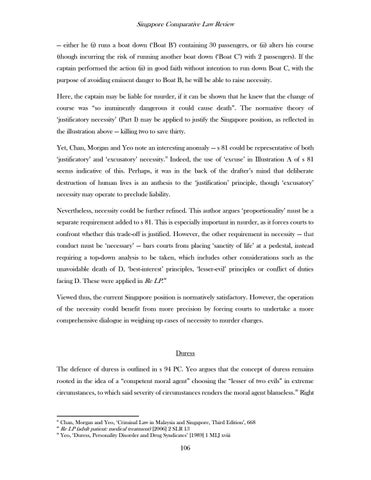Singapore Comparative Law Review — either he (i) runs a boat down (‘Boat B’) containing 30 passengers, or (ii) alters his course (though incurring the risk of running another boat down (‘Boat C’) with 2 passengers). If the captain performed the action (ii) in good faith without intention to run down Boat C, with the purpose of avoiding eminent danger to Boat B, he will be able to raise necessity. Here, the captain may be liable for murder, if it can be shown that he knew that the change of course was “so imminently dangerous it could cause death”. The normative theory of ‘justificatory necessity’ (Part I) may be applied to justify the Singapore position, as reflected in the illustration above — killing two to save thirty. Yet, Chan, Morgan and Yeo note an interesting anomaly — s 81 could be representative of both ‘justificatory’ and ‘excusatory’ necessity.31 Indeed, the use of ‘excuse’ in Illustration A of s 81 seems indicative of this. Perhaps, it was in the back of the drafter’s mind that deliberate destruction of human lives is an anthesis to the ‘justification’ principle, though ‘excusatory’ necessity may operate to preclude liability. Nevertheless, necessity could be further refined. This author argues ‘proportionality’ must be a separate requirement added to s 81. This is especially important in murder, as it forces courts to confront whether this trade-off is justified. However, the other requirement in necessity — that conduct must be ‘necessary’ — bars courts from placing ‘sanctity of life’ at a pedestal, instead requiring a top-down analysis to be taken, which includes other considerations such as the unavoidable death of D, ‘best-interest’ principles, ‘lesser-evil’ principles or conflict of duties facing D. These were applied in Re LP.32 Viewed thus, the current Singapore position is normatively satisfactory. However, the operation of the necessity could benefit from more precision by forcing courts to undertake a more comprehensive dialogue in weighing up cases of necessity to murder charges.
Duress The defence of duress is outlined in s 94 PC. Yeo argues that the concept of duress remains rooted in the idea of a “competent moral agent” choosing the “lesser of two evils” in extreme circumstances, to which said severity of circumstances renders the moral agent blameless. 33 Right
31 32 33
Chan, Morgan and Yeo, ‘Criminal Law in Malaysia and Singapore, Third Edition’, 668
Re LP (adult patient: medical treatment) [2006] 2 SLR 13
Yeo, ‘Duress, Personality Disorder and Drug Syndicates’ [1989] 1 MLJ xviii
106
